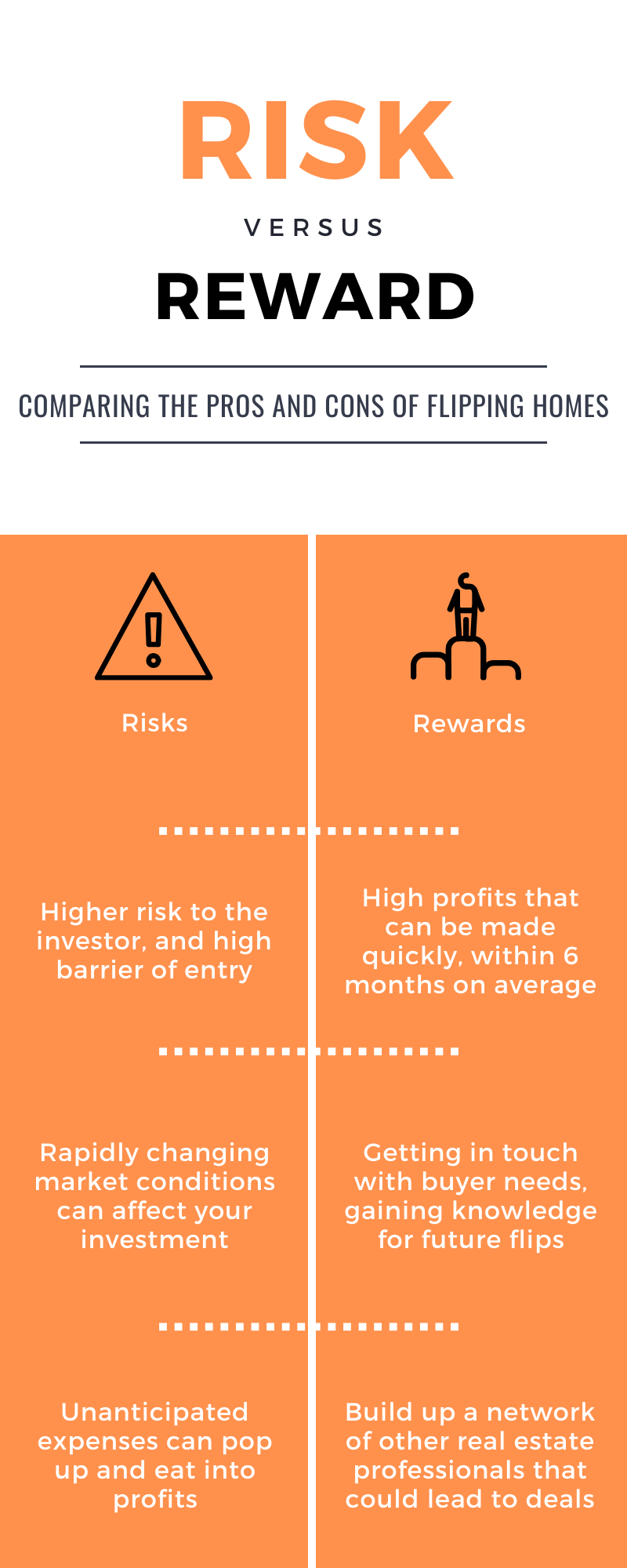Flipping houses can be a particularly lucrative real estate investment strategy, but it’s definitely not suitable for every kind of investor. HGTV likes to paint images of flips that end well every time, but the reality is that these types of projects not only take a lot of capital but also take up a lot of time and effort compared to other, more passive real estate investments.
The real estate investor needs to know their market, have an established network of expert service providers, and be able to accurately estimate renovation costs amongst many other responsibilities – no easy feat to say the least.
Jump To:
When it comes to investing in flipping houses successfully, you need to have a strategic plan in place that will help you reach your overall financial goals with as little room for error as possible. If a fix and flip investment is something you have been considering taking on, you’ll need to know some of the pros and cons you will be faced with before you get started, or else you run the risk of sinking your money instead. With flipping, returns are not necessarily guaranteed, and if you buy a great property in a bad area then no amount of renovation is going to make buyers interested
Here are some of the pros and cons to know before investing in flipping houses that will help you avoid pitfalls.
Pros of Flipping Houses
Pro: Quick Profits
Arguably one of the biggest draws to investing in fix and flips is the possibility of turning profits quickly. Few other real estate investments offer the ability to make such a high profit with such a short turnaround time. The length of the average flip is around 6 months, although this period could be as short as 3-4 months. The average returns on these projects
are over $60,000 but could be higher or lower depending on the location of the property. Flipping houses when managed correctly and kept on budget, can bring in high profits depending on the location, budget, and purchase price that the investor settles for. You can use the New Silver Cap Rate Calculator which factors in the property value, gross rental income, vacancy rate, and operation expenses.
Fix and flip properties can come in all shapes, sizes, and conditions – the investor can choose the level of effort they are willing to do to reach a high valuation. Some investors choose to purchase turnkey homes which will need minimal renovation effort prior to selling, while others specialize in transforming properties that other investors won’t touch. These properties don’t have to be just normal residential projects either – some investors prefer flipping commercial properties. Commercial flips behave slightly differently from residential projects and may take longer as a whole, but for higher payoffs.
Pro: Understanding Buyer Needs
Once you have one successful flip under your belt, you will get a deeper understanding of what buyers want and will find value when it comes to new houses on the market. This newfound, first-hand knowledge can be applied to future projects and help you build more profitability as an investor and put you on an upward trajectory.
Flipping will also increase your knowledge of real estate as a whole and enable you to spot more opportunities or build up your confidence in taking on more serious renovations. The importance of knowing what buyers want can not be underestimated – what you may consider being the perfect property may not be to buyers, and leave you with a vacant property with no good offers.
Since house flips are taken on and completed in such a short timeframe, you can really focus your renovations on what buyers currently want. The challenge in doing a home renovation is that many improvement projects will not add tangible value to the property and cause you to take on unnecessary expenses that won’t help you set a higher asking price. There are certain renovations that are always popular with buyers – kitchens, flooring, and storage space always score highly, as does building an additional bathroom. While there are home renovations that come and go, it’s best to stick to the classics for the best results.
The key is to balance these renovations with what buyers need from the location of the property. Buyers with families will look for good school districts, while younger, solo buyers may be more interested in proximity to job hubs and nightlife. Paying attention to these wants and needs will not only increase the property value but also ensure that you’ll be able to sell the property quickly. In 2023, the average amount of time required to sell a home — from listing through closing — is approximately 54 days.
Pro: Building Your Real Estate Network
When completing a fix and flip, you will find yourself building up a network of new contacts throughout the course of your project. This network can include individuals that are realtors, property appraisers, real estate attorneys, and other investors to name a few examples. Networking is one of the biggest parts of real estate and can be a way to find valuable off-the-market deals that no other investor has access to. These contacts can be useful in your future investments, so make sure to keep in contact with your network regularly and keep tabs on any opportunities they may have for you.
This network may also lead you to another real estate investor you can partner with on future projects. Partnering with another investor can help you take on larger projects with more confidence. Some individuals prefer to work alone, while others prefer to have another person providing financial and managerial input. The greatest benefits of working with a partner investor include more capital, shared responsibilities, and shared risk.
Working with another investor can also be extremely valuable if you are a new investor or have little of your own funds available. As a less experienced property investor and flipper, teaming up with someone that has done this before can help you avoid some of the more costly and common pitfalls that come with the flipping process. Of course, having a partner can also come with its own set of challenges. Real estate investing and business partnerships can be rewarding, bringing advantages to all involved parties, but if not managed well, it can be a financial disaster.
Cons of Flipping Houses
Con: High Risk
Fix and flips can be riskier to undertake than other real estate investments. Several factors can lead to financial losses in this type of investment – your renovations can take longer than expected, the local real estate market may go cold and if you can’t find a buyer or tenant the holding costs can quickly pile up. If you are unable to manage the budget and deadline of the project effectively it can quickly become unprofitable, especially detrimental if you are funding your flip with a loan.
Another risk factor, as seen with the recent outbreak of COVID-19, market conditions can change rapidly and affect your investment negatively. There is no way to predict this type of situation, and many real estate investors were caught off guard by the rapid change of events. Before COVID-19 the market was fundamentally strong, leasing activity was high and there was plenty of capital to be invested. Now, real estate investors are at risk of varying impacts – tenants are unable to pay rent, construction could not be completed due to stay-at-home orders and supply chains of materials have been disrupted. A vastly different environment to the same time last year.
Due to the risk involved, it can be difficult for solo investors with little fix and flip experience to get into – in these cases, the gaps in their knowledge could be detrimental to their project and cost them valuable time and money that could be better spent elsewhere. The most successful real estate flippers are the ones who can mitigate risks and adapt quickly as challenges arise, which is often. Getting to that level of experience can take some trial and error.
Con: Unanticipated Expenses
One of the biggest cons of flipping houses is having to provision for and deal with unanticipated expenses. Any expenses that pop up outside of your budget will very quickly eat into any potential profits you may have been able to earn at closing. If markets soften as they have this year, you may have to make seller concessions to your buyer that will leave you compromising on your initial asking price. Selling your fix and flip as soon as possible after the renovation has been completed is key, or else you will be responsible for holding costs for unknown amounts of time. The reality is that longer times on the market can motivate you to accept lower offers.
There are also expenses that can be planned for and which the real estate investor will be responsible for. Closing costs include a host of additional expenses such as property taxes, insurance, title company fees, and more. If you are flipping on your own dime, there will be other costs associated with the sale of your flip property. The general guideline for investors flipping houses is that closing costs can amount to up to 5% of the property purchase price.
Final Thoughts
Fix and flips can be extremely lucrative and come with a lot of pros for the investor willing to put in the time, effort, and money to make their project successful. On the flip side, there are cons to be contented with that may put many investors off of flipping houses.
These projects can be riskier, difficult to keep in budget and unexpected expenses can quickly pile up. Not all home flips are successful, but the ones that bring the investor high profits with quick turnaround times, teach them useful tips and tricks for future flip projects, and build up the investor’s network of other real estate professionals.




